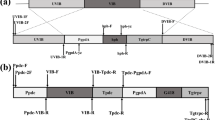Abstract
Objective
Improve the hydrolysis efficiency of the Trichoderma reesei cellulase system by heterologously expressing cellobiohydrolase Cel7A (Te-Cel7A) from the thermophilic fungus Talaromyces emersonii.
Results
Te-Cel7A was expressed in T. reesei under control of the cdna1 promoter and the generated transformant QTC14 could successfully secrete Te-Cel7A into the supernatant using glucose as carbon source. The recombinant Te-Cel7A had a temperature optimum at 65 °C and an optimal pH of 5, which were similar to those from the native host. The culture supernatant of QTC14 exhibited a 28.8% enhancement in cellobiohydrolase activity and a 65.2% increase in filter paper activity relative to that of the parental strain QP4. Moreover, the QTC14 cellulase system showed higher thermal stability than that of the parental strain QP4. In the saccharification of delignified corncob residue, the cellulose conversion of QTC14 showed 13.9% higher than that of QP4 at the end of reaction.
Conclusions
The thermophilic fungus-derived cellulases could be efficiently expressed by T. reesei and the recombinant cellulases had potential applications for biomass conversion.



Similar content being viewed by others
References
Anbar M, Gul O, Lamed R, Sezerman UO, Bayer EA (2012) Improved thermostability of Clostridium thermocellum endoglucanase Cel8A by using consensus-guided mutagenesis. Appl Environ Microbiol 78:3458–3464
Dashtban M, Schraft H, Qin W (2009) Fungal bioconversion of lignocellulosic residues; opportunities & perspectives. Int J Biol Sci 5:578–595
Gao J, Qian Y, Wang Y, Qu Y, Zhong Y (2017) Production of the versatile cellulase for cellulose bioconversion and cellulase inducer synthesis by genetic improvement of Trichoderma reesei. Biotechnol Biofuels 10:272
Ghose TK (1987) Measurement of cellulase activities. Pure Appl Chem 59:257–268
Hartl L, Seiboth B (2005) Sequential gene deletions in Hypocrea jecorina using a single blaster cassette. Curr Genet 48:204–211
Hong J, Tamaki H, Yamamoto K, Kumagai H (2003) Cloning of a gene encoding thermostable cellobiohydrolase from Thermoascus aurantiacus and its expression in yeast. Appl Microbiol Biotechnol 63:42–50
Kubicek CP, Kubicek EM (2016) Enzymatic deconstruction of plant biomass by fungal enzymes. Curr Opin Chem 35:51–57
Lynd LR, Weimer PJ, van Zyl WH, Pretorius IS (2002) Microbial cellulose utilization: fundamentals and biotechnology. Microbiol Mol Biol Rev 66:506–577
McHale A, Coughlan MP (1980) Synergistic hydrolysis of cellulose by components of the extracellular cellulase system of Talaromyces emersonii. FEBS Lett 117:319–322
Penttilä M, Nevalainen H, Rättö M, Salminen E, Knowles J (1987) A versatile transformation system for the cellulolytic filamentous fungus Trichoderma reesei. Gene 61:155–164
Qian Y, Zhong L, Hou Y, Qu Y, Zhong Y (2016) Characterization and strain improvement of a hypercellulytic variant, Trichoderma reesei SN1, by genetic engineering for optimized cellulase production in biomass conversion improvement. Front Microbiol 7:1349
Qian Y, Zhong L, Gao J, Sun N, Wang Y, Sun G, Qu Y, Zhong Y (2017) Production of highly efficient cellulase mixtures by genetically exploiting the potentials of Trichoderma reesei endogenous cellulases for hydrolysis of corncob residues. Microb Cell Fact 16:207
Sipos B, Benko Z, Dienes D, Réczey K, Viikari L, Siika-aho M (2010) Characterisation of specific activities and hydrolytic properties of cell-wall-degrading enzymes produced by Trichoderma reesei Rut C30 on different carbon sources. Appl Biochem Biotechnol 161:347–364
Tuohy MG, Walsh DJ, Murray PG, Claeyssens M, Cuffe MM, Savage AV, Coughlan MP (2002) Kinetic parameters and mode of action of the cellobiohydrolases produced by Talaromyces emersonii. Biochim Biophys Acta 1596:366–380
Uzbas F, Sezerman U, Hartl L, Kubicek CP, Seiboth B (2012) A homologous production system for Trichoderma reesei secreted proteins in a cellulase-free background. Appl Microbiol Biotechnol 93:1601–1608
Voutilainen SP, Puranen T, Siika-Aho M, Lappalainen A, Alapuranen M, Kallio J, Hooman S, Viikari L, Vehmaanperä J, Koivula A (2008) Cloning, expression, and characterization of novel thermostable family 7 cellobiohydrolases. Biotechnol Bioeng 101:515–528
Voutilainen SP, Murray PG, Tuohy MG, Koivula A (2010) Expression of Talaromyces emersonii cellobiohydrolase Cel7A in Saccharomyces cerevisiae and rational mutagenesis to improve its thermostability and activity. Protein Eng Des Sel 23:69–79
Yu JH, Hamari Z, Han KH, Seo JA, Reyes-Domínguez Y, Scazzocchio C (2004) Double-joint PCR: a PCR-based molecular tool for gene manipulations in filamentous fungi. Fungal Genet Biol 41:973–981
Acknowledgements
This work was supported by the grants from the National Natural Science Foundation of China (No. 31370135) and the Major Research Projects of Shandong Province (2017GSF21111 and 2016GGH3103).
Author information
Authors and Affiliations
Corresponding authors
Rights and permissions
About this article
Cite this article
Sun, N., Qian, Y., Wang, W. et al. Heterologous expression of Talaromyces emersonii cellobiohydrolase Cel7A in Trichoderma reesei increases the efficiency of corncob residues saccharification. Biotechnol Lett 40, 1119–1126 (2018). https://doi.org/10.1007/s10529-018-2564-x
Received:
Accepted:
Published:
Issue Date:
DOI: https://doi.org/10.1007/s10529-018-2564-x




